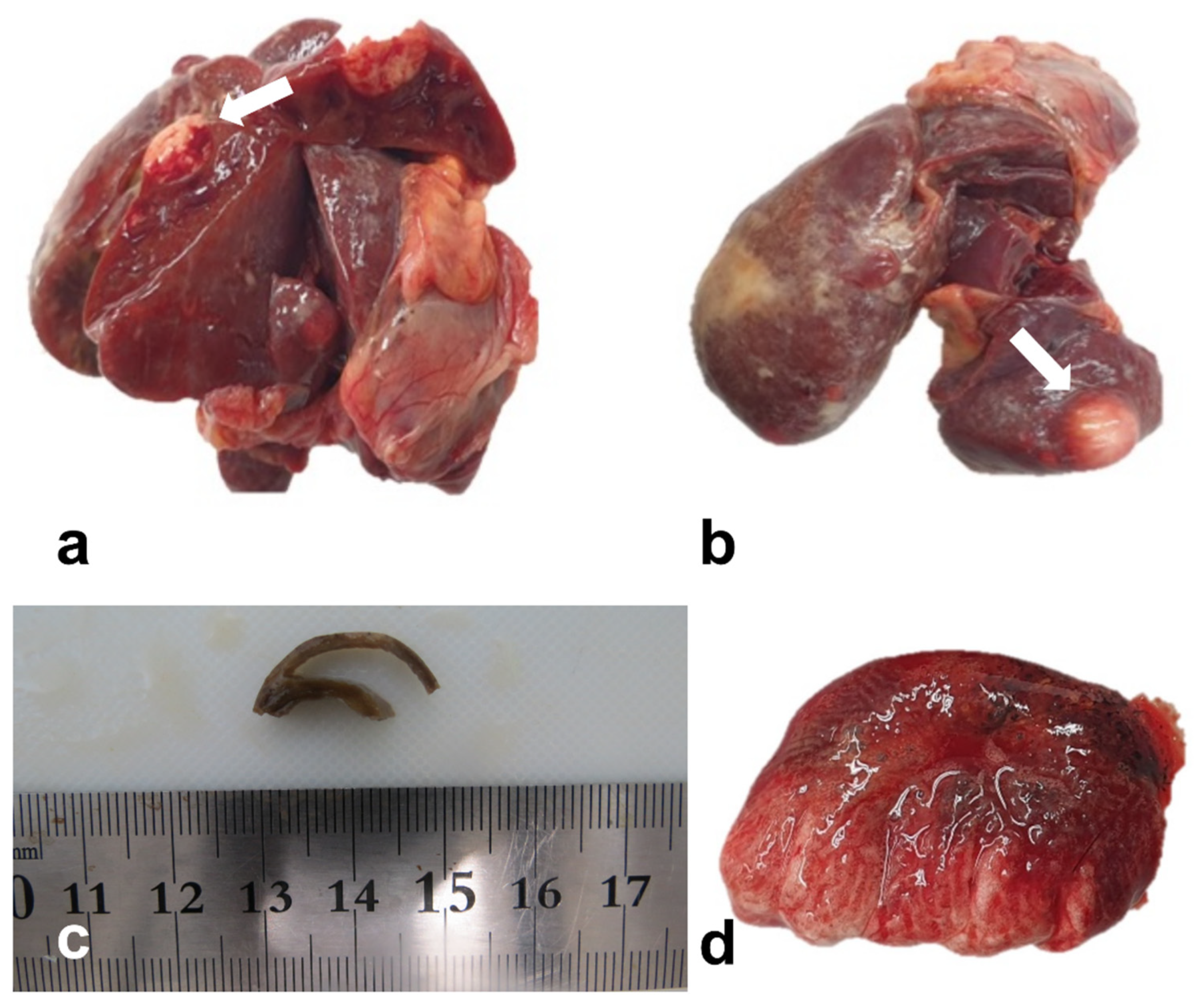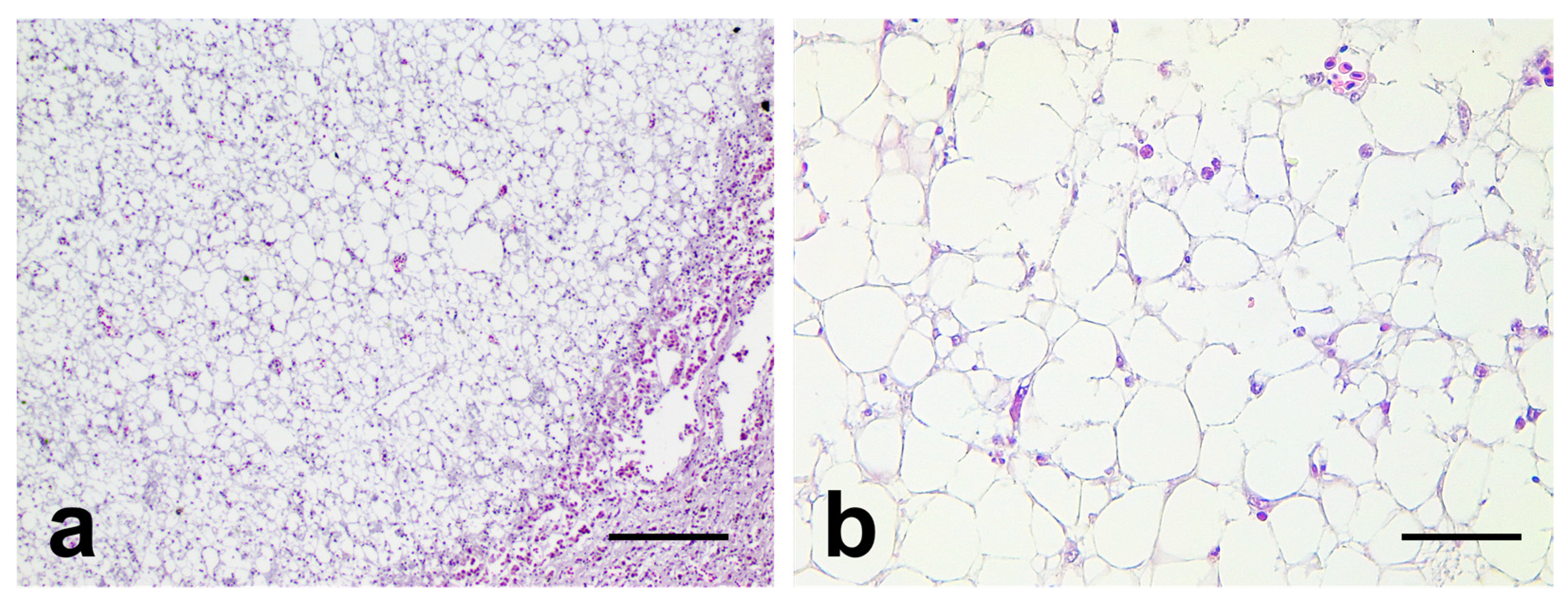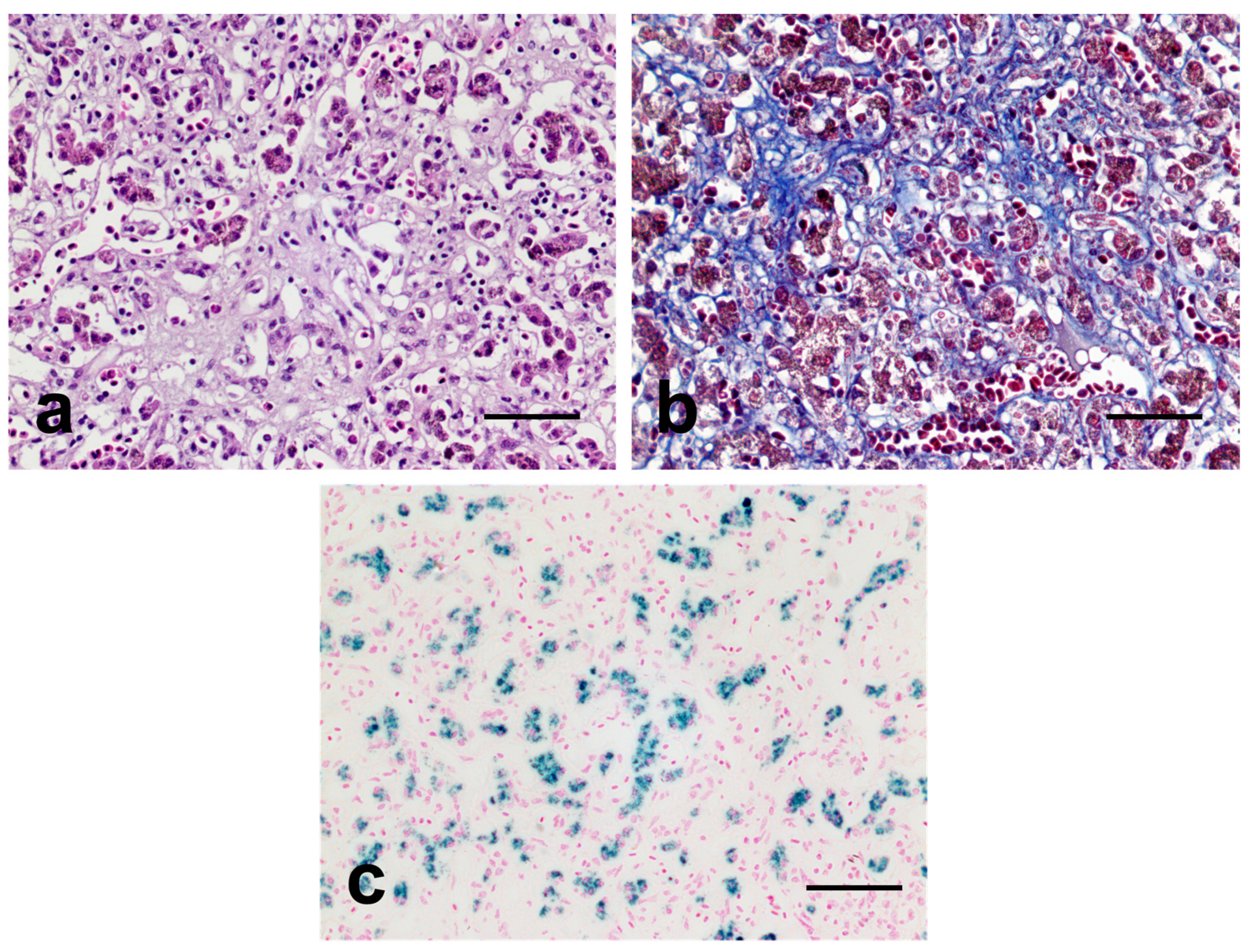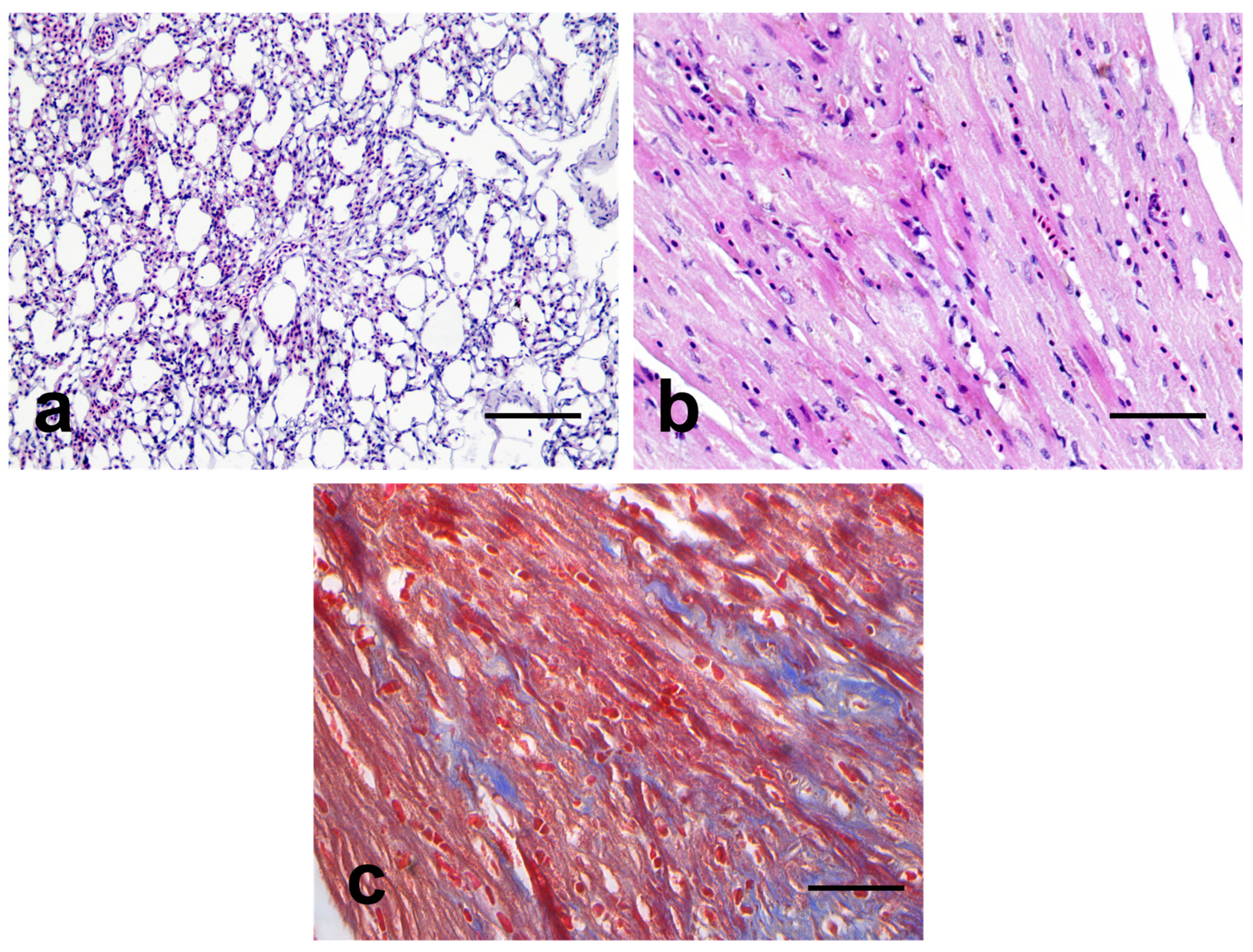Multiple Hepatic Lipoma: A Case Report of Captive Hill Mynah with Iron Storage Disease
Abstract
:Simple Summary
Abstract
1. Introduction
2. Case Presentation
3. Discussion
4. Conclusions
Supplementary Materials
Author Contributions
Funding
Institutional Review Board Statement
Informed Consent Statement
Data Availability Statement
Acknowledgments
Conflicts of Interest
References
- Feare, C. The Starling; Oxford University Press: Oxford, NY, USA, 1984. [Google Scholar]
- Feare, C.; Craig, A. Starlings and Mynas; Princeton University Press: Princeton, NJ, USA, 1999. [Google Scholar]
- Sajeva, M.; Carimi, F.; McGough, N. The convention on international trade in endangered species of wild fauna and flora (CITES) and its role in conservation of cacti and other succulent plants. Funct. Ecosyst. Communities 2007, 1, 80–85. [Google Scholar]
- Archawaranon, M. Captive Hill Mynah Gracula religiosa breeding success: Potential for bird conservation in Thailand? Bird Conserv. Int. 2005, 15, 327–335. [Google Scholar] [CrossRef]
- Martin-Benitez, G.; Marti-Bonmati, L.; Barber, C.; Vila, R. Hepatic lipomas and steatosis: An association beyond chance. Eur. J. Radiol. 2012, 81, e491–e494. [Google Scholar] [CrossRef] [PubMed]
- Stimmelmayr, R.; Rotstein, D.; Seguel, M.; Gottdenker, N. Hepatic lipomas and myelolipomas in subsistence-harvested bowhead whales Balaena mysticetus, Alaska (USA): A case review 1980–2016. Dis. Aquat. Org. 2017, 127, 71–74. [Google Scholar] [CrossRef]
- Rezaie, A.; Mohammadian, B.; Hossein Zadeh, S.K.; Anbari, S. Benign mesenchymal hepatic tumors in camels (Camelus dromedarius). Iran. J. Vet. Sci. Technol. 2015, 7, 20–27. [Google Scholar]
- de la Vega, M.; Robbins, M.; Howes, M.; Vieson, M. Liver Lipoma in a Dog: Case Report and Literature Review. J. Am. Anim. Hosp. Assoc. 2023, 59, 188–192. [Google Scholar] [CrossRef]
- Latimer, K.; Rakich, P. Subcutaneous and hepatic myelolipomas in four exotic birds. Vet. Pathol. 1995, 32, 84–87. [Google Scholar] [CrossRef]
- Musa, I.; Sani, N.; Gaba, E.; Lawal, M. Subcuteneous and Deep Lipomas in Exotic and Nigerian Indigenous Chickens: A Case Report. Poult. Sci. J. 2019, 7, 1–6. [Google Scholar]
- Abbaspour, N.; Hurrell, R.; Kelishadi, R. Review on iron and its importance for human health. J. Res. Med. Sci. Off. J. Isfahan Univ. Med. Sci. 2014, 19, 164. [Google Scholar]
- Emerit, J.; Beaumont, C.; Trivin, F. Iron metabolism, free radicals, and oxidative injury. Biomed. Pharmacother. 2001, 55, 333–339. [Google Scholar] [CrossRef]
- Beutler, E. Iron storage disease: Facts, fiction and progress. Blood Cells Mol. Dis. 2007, 39, 140–147. [Google Scholar] [CrossRef] [PubMed]
- Fernández-Real, J.M.; Manco, M. Effects of iron overload on chronic metabolic diseases. Lancet Diabetes Endocrinol. 2014, 2, 513–526. [Google Scholar] [CrossRef] [PubMed]
- Torti, S.V.; Manz, D.H.; Paul, B.T.; Blanchette-Farra, N.; Torti, F.M. Iron and cancer. Annu. Rev. Nutr. 2018, 38, 97–125. [Google Scholar] [CrossRef]
- Miller, E.R.; Fowler, M.E. Fowler’s Zoo and Wild Animal Medicine; Elsevier Health Sciences: Amsterdam, The Netherlands, 2014; Volume 8. [Google Scholar]
- Mete, A.; Hendriks, H.; Klaren, P.; Dorrestein, G.; Van Dijk, J.; Marx, J. Iron metabolism in mynah birds (Gracula religiosa) resembles human hereditary haemochromatosis. Avian Pathol. 2003, 32, 625–632. [Google Scholar] [CrossRef] [PubMed]
- Kamimura, K.; Nomoto, M.; Aoyagi, Y. Hepatic angiomyolipoma: Diagnostic findings and management. Int. J. Hepatol. 2012, 2012, 410781. [Google Scholar] [CrossRef]
- Brunt, E.M.; Kleiner, D.E.; Carpenter, D.H.; Rinella, M.; Harrison, S.A.; Loomba, R.; Younossi, Z.; Neuschwander-Tetri, B.A.; Sanyal, A.J.; for the American Association for the Study of Liver Diseases NASH Task Force. NAFLD: Reporting histologic findings in clinical practice. Hepatology 2021, 73, 2028–2038. [Google Scholar] [CrossRef]
- Nakamura, N.; Kudo, A.; Ito, K.; Tanaka, S.; Arii, S. A hepatic lipoma mimicking angiomyolipoma of the liver: Report of a case. Surg. Today 2009, 39, 825–828. [Google Scholar] [CrossRef]
- Jalili, N.; Zaeemi, M.; Razmyar, J.; Azizzadeh, M. Comparison of iron chelators used alone or in combination with phlebotomy in common mynahs (Acridotheres tristis) with experimental iron storage disease. Avian Pathol. 2021, 50, 350–356. [Google Scholar] [CrossRef]
- de Oliveira, A.R.; Dos Santos, D.O.; Pereira, M.d.P.M.; de Carvalho, T.F.; Tinoco, H.P.; Pessanha, A.T.; da Costa, M.E.L.T.; Coelho, C.M.; da Paixão, T.A.; de Carvalho, M.P.N. A retrospective study of hepatic hemosiderosis and iron storage disease in several captive and free-ranging avian species. J. Zoo Wildl. Med. 2022, 53, 455–460. [Google Scholar] [CrossRef]
- Dreifuss, N.H.; Ramallo, D.; McCormack, L. Multifocal nodular fatty infiltration of the liver: A rare Benign disorder that mimics metastatic liver disease. ACG Case Rep. J. 2021, 8, e00537. [Google Scholar] [CrossRef]
- Valls, C.; Alba, E.; Murakami, T.; Hori, M.; Passariello, R.; Vilgrain, V. Fat in the liver: Diagnosis and characterization. Eur. Radiol. 2006, 16, 2292–2308. [Google Scholar] [CrossRef] [PubMed]
- Manenti, G.; Picchi, E.; Castrignanò, A.; Muto, M.; Nezzo, M.; Floris, R. Liver lipoma: A case report. BJR Case Rep. 2017, 3, 20150467. [Google Scholar] [CrossRef]
- Basaran, C.; Karcaaltincaba, M.; Akata, D.; Karabulut, N.; Akinci, D.; Ozmen, M.; Akhan, O. Fat-containing lesions of the liver: Cross-sectional imaging findings with emphasis on MRI. Am. J. Roentgenol. 2005, 184, 1103–1110. [Google Scholar] [CrossRef] [PubMed]
- Martí-Bonmatí, L.; Menor, F.; Vizcaino, I.; Vilar, J. Lipoma of the liver: US, CT, and MRI appearance. Gastrointest. Radiol. 1989, 14, 155–157. [Google Scholar] [CrossRef]
- Prasad, S.R.; Wang, H.; Rosas, H.; Menias, C.O.; Narra, V.R.; Middleton, W.D.; Heiken, J.P. Fat-containing lesions of the liver: Radiologic-pathologic correlation. Radiographics 2005, 25, 321–331. [Google Scholar] [CrossRef] [PubMed]
- Choi, B.Y.; Nguyen, M.H. The diagnosis and management of benign hepatic tumors. J. Clin. Gastroenterol. 2005, 39, 401–412. [Google Scholar] [CrossRef]
- Li, G.; Yu, W.; Yang, H.; Wang, X.; Ma, T.; Luo, X. Relationship between Serum Ferritin Level and Dyslipidemia in US Adults Based on Data from the National Health and Nutrition Examination Surveys 2017 to 2020. Nutrients 2023, 15, 1878. [Google Scholar] [CrossRef]
- Rajpathak, S.N.; Crandall, J.P.; Wylie-Rosett, J.; Kabat, G.C.; Rohan, T.E.; Hu, F.B. The role of iron in type 2 diabetes in humans. Biochim. Et Biophys. Acta (BBA)—Gen. Subj. 2009, 1790, 671–681. [Google Scholar] [CrossRef]
- Kasztura, M.; Kiczak, L.; Pasławska, U.; Bania, J.; Janiszewski, A.; Tomaszek, A.; Zacharski, M.; Noszczyk-Nowak, A.; Pasławski, R.; Tabiś, A. Hemosiderin Accumulation in Liver Decreases Iron Availability in Tachycardia-Induced Porcine Congestive Heart Failure Model. Int. J. Mol. Sci. 2022, 23, 1026. [Google Scholar] [CrossRef]
- Boyer, S. Are You Feeding Your Myna to Death? AFA Watchb. 2000, 27, 58–59. [Google Scholar]
- Mete, A.; Dorrestein, G.; Marx, J.; Lemmens, A.; Beynen, A. A comparative study of iron retention in mynahs, doves and rats. Avian Pathol. 2001, 30, 479–486. [Google Scholar] [CrossRef] [PubMed]




| Case | Age | Sex | Date (dd.mm.yy) | Blood Iron Level (μg/dL) |
|---|---|---|---|---|
| Control bird 1 | 10 | Unknown | 28.10.19 | 134 |
| 10.11.20 | 71 | |||
| 11.03.21 | 101 | |||
| Control bird 2 | 15 | Female | 29.10.19 | 137 |
| Control bird 3 | 15 | Male | 29.10.19 | 116 |
| 10.11.20 | 93 | |||
| Control bird 4 | 15 | Male | 29.10.19 | 106 |
| 10.11.20 | 76 | |||
| Subject 5 * | 21 | Female | 07.07.19 | 101 |
| 10.11.20 | 99 |
Disclaimer/Publisher’s Note: The statements, opinions and data contained in all publications are solely those of the individual author(s) and contributor(s) and not of MDPI and/or the editor(s). MDPI and/or the editor(s) disclaim responsibility for any injury to people or property resulting from any ideas, methods, instructions or products referred to in the content. |
© 2023 by the authors. Licensee MDPI, Basel, Switzerland. This article is an open access article distributed under the terms and conditions of the Creative Commons Attribution (CC BY) license (https://creativecommons.org/licenses/by/4.0/).
Share and Cite
Lee, S.-W.; Youn, S.-H.; Park, J.-K. Multiple Hepatic Lipoma: A Case Report of Captive Hill Mynah with Iron Storage Disease. Vet. Sci. 2023, 10, 626. https://doi.org/10.3390/vetsci10100626
Lee S-W, Youn S-H, Park J-K. Multiple Hepatic Lipoma: A Case Report of Captive Hill Mynah with Iron Storage Disease. Veterinary Sciences. 2023; 10(10):626. https://doi.org/10.3390/vetsci10100626
Chicago/Turabian StyleLee, Seoungw-Woo, Soong-Hee Youn, and Jin-Kyu Park. 2023. "Multiple Hepatic Lipoma: A Case Report of Captive Hill Mynah with Iron Storage Disease" Veterinary Sciences 10, no. 10: 626. https://doi.org/10.3390/vetsci10100626
APA StyleLee, S.-W., Youn, S.-H., & Park, J.-K. (2023). Multiple Hepatic Lipoma: A Case Report of Captive Hill Mynah with Iron Storage Disease. Veterinary Sciences, 10(10), 626. https://doi.org/10.3390/vetsci10100626







